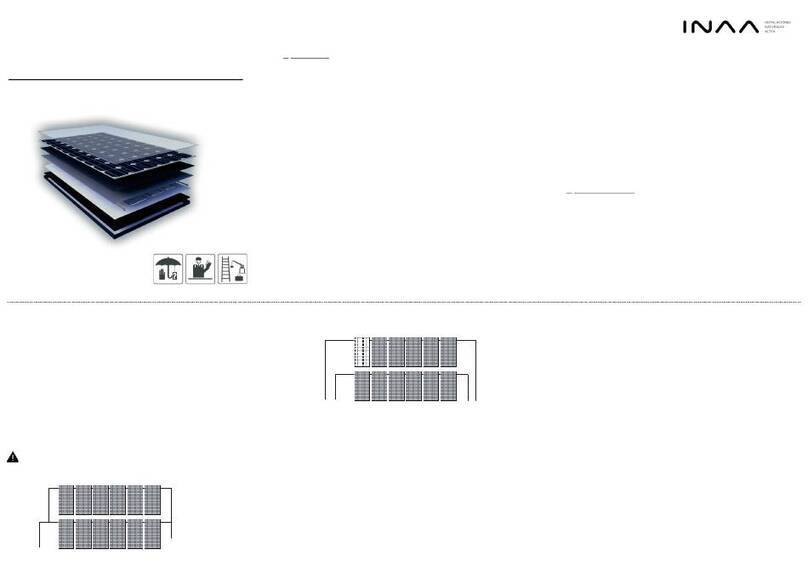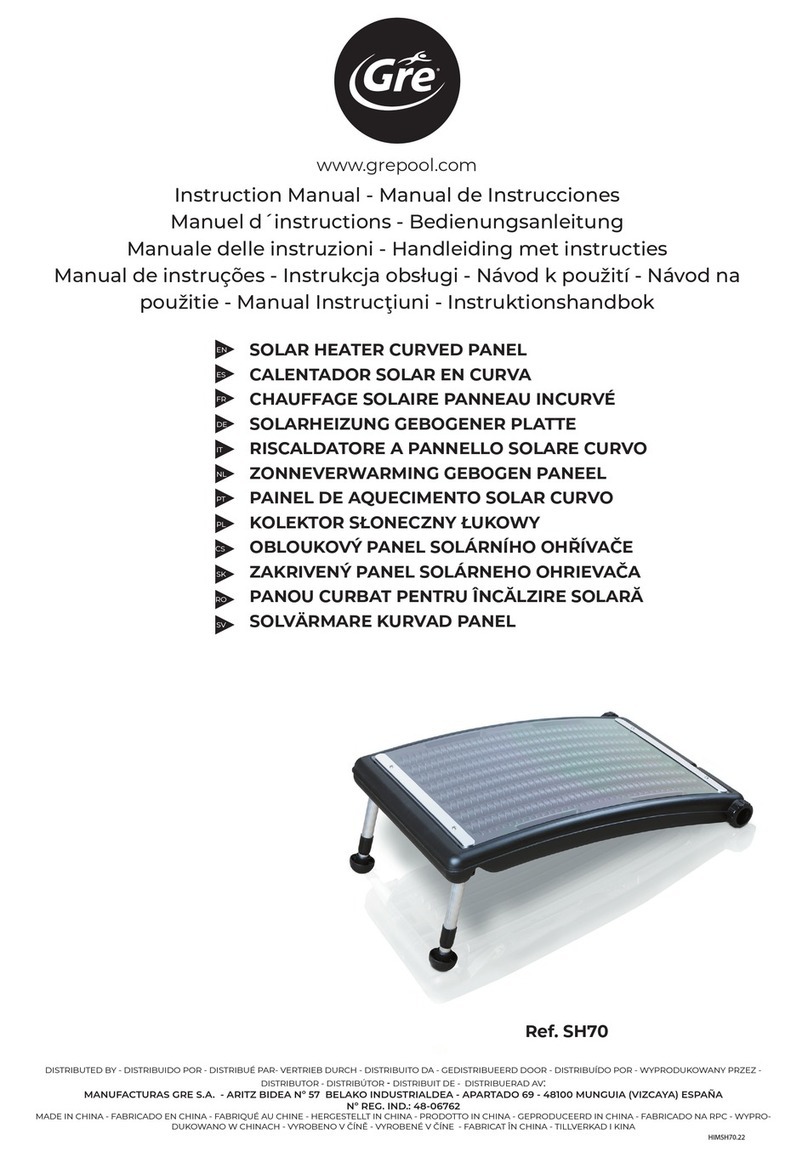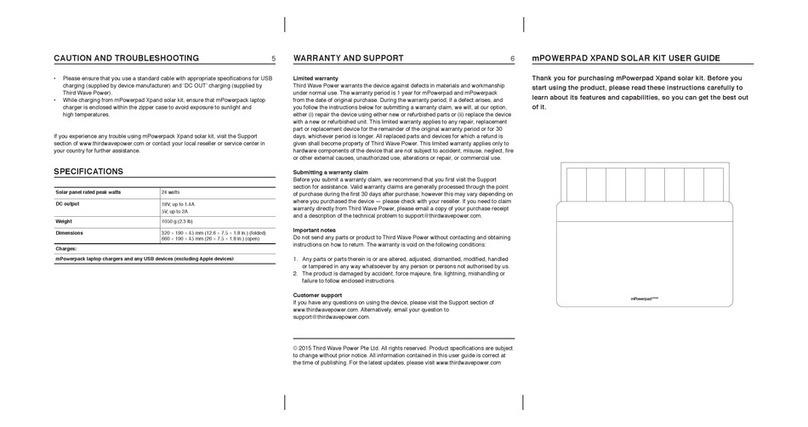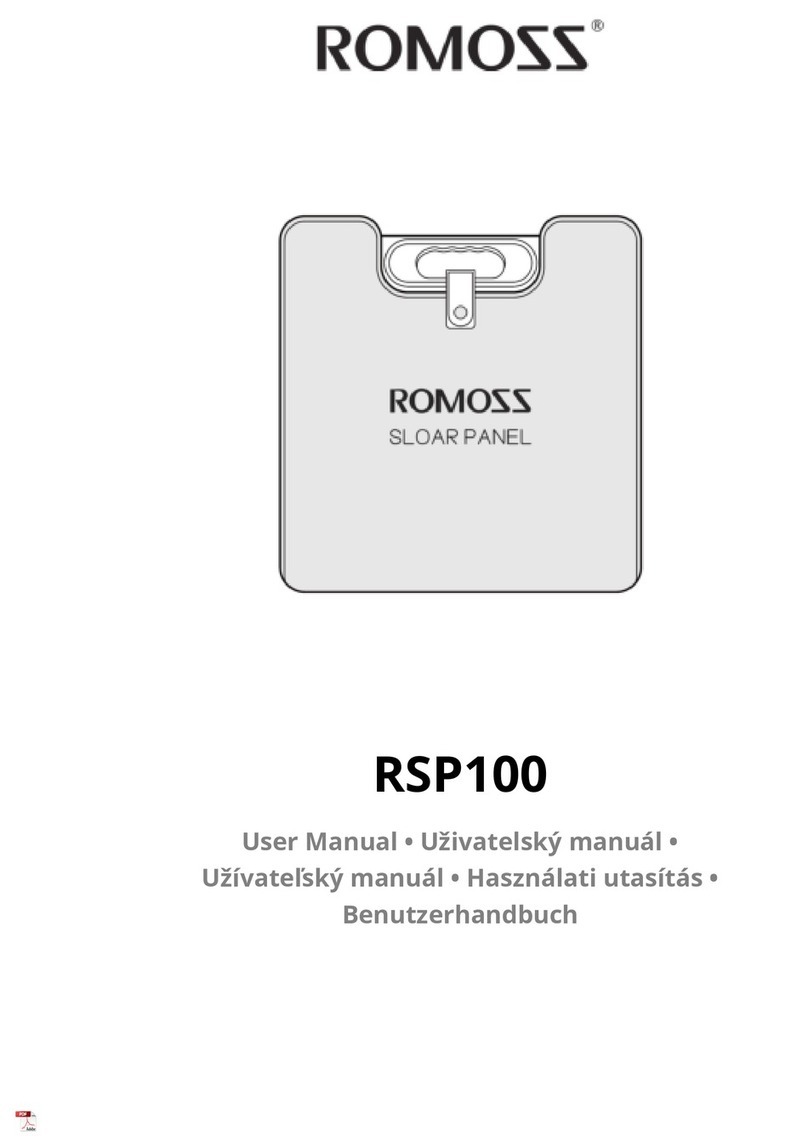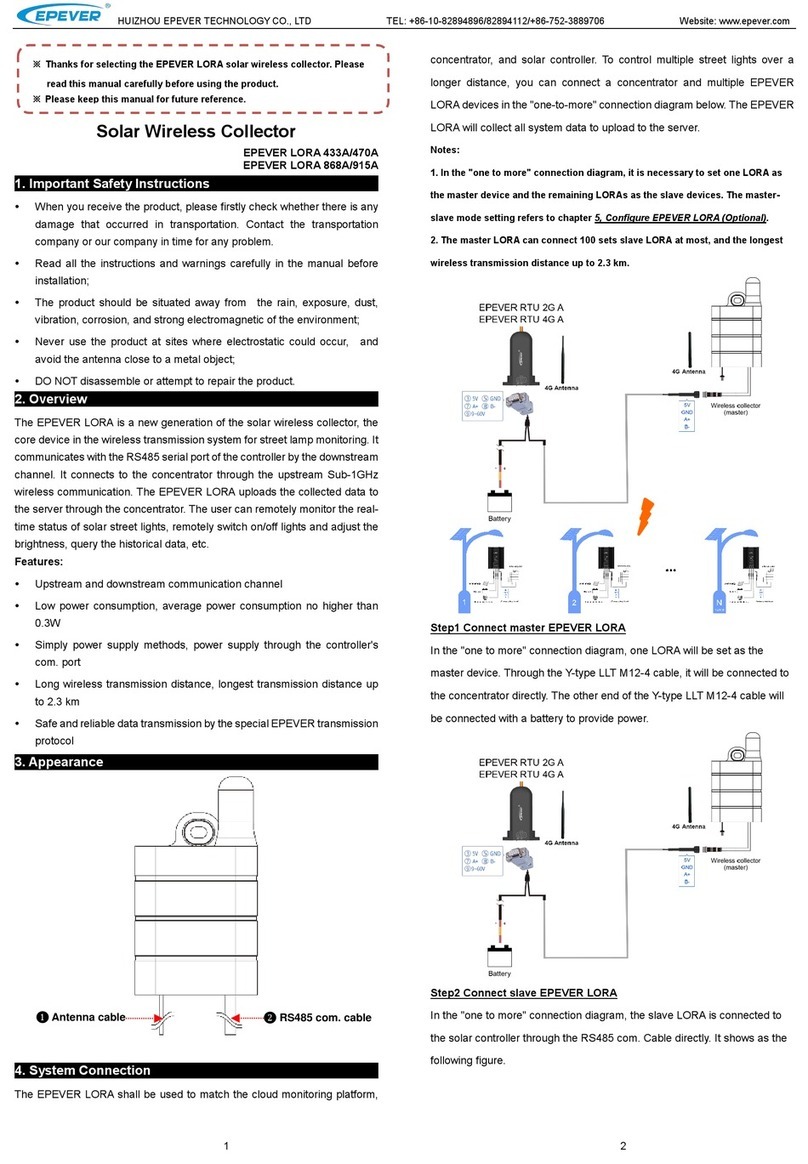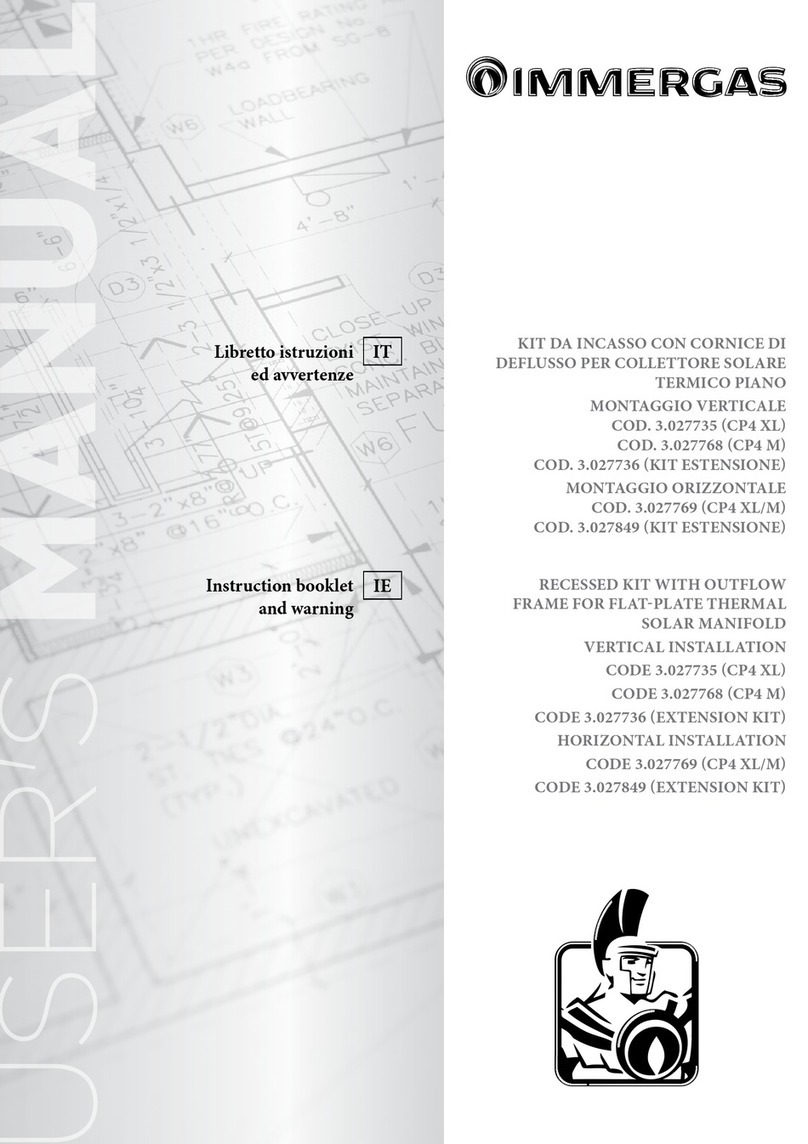inaa SR10 User manual

1. Important Information
1.1. Local Standards
Installation must be completed in accordance with the relevant local standards and regulations.
1.2. Qualified Installer
Installation must be completed by qualified plumbing professionals.
1.3. Pressure and Temperature Control and Relief.
Solar loop should be designed for normal operation at <600kpa via use of a pressure limiting (pressure reduction)
valve on the mains cold supply line. System design must provide mean for allowing pressure release at no more
than 800kpa (113psi) and hot water dumping from the solar loop or storage tank once the temperature reaches
99℃(210F). It is recommended that the lever on the pressure and temperature relief valve (PTRV) be operated
once every 6 months ensure reliable operation. It is important to raise and lower the lever gently.
1.4. Water Quality
Water in direct flow through the manifold header must firstly meet potable water requirement and in addition the
following:
Total dissolved solids < 600mg/litre or p.p.m
Total hardness < 200mg/litre or p.p.m
Chloride < 250mg/litre or p.p.m
Magnesium < 10mg/litre or p.p.m
In areas with hard water (>200ppm), line scale may from inside in header pipe. In such regions, it is advisable to in
stall a water softening device to ensure the long term efficient operation of the collector, or use a closed loop for the
solar circulation loop. If using a glycol/water must meet the above requirements, and the glycol must be changed
periodically to prevent the glycol from becoming acidic.
1.5. Metallic Corrosion
Both copper & stainless steel are susceptible to corrosion when high concentrations of chloride are present. The solar
collector may be used for heating of spa or pool water, but levels of free chorine must not exceed 2ppm.in addition
the warranty provided on the header when using for spa or pool heating is 2 years, which is the standard for spa and
pool heaters. Chloride level present in most reticulated pubic potable water supplies are safe for use in the collector
provided there is no use of bore waters in the reticulated supply.
The glass evacuated tubes are surprisingly strong and able to handle significant impact stresses once installed. Testing
connections the services of a qualified professional must be employed.
1.6. Freeze Protection
Freeze protection should be in corporate into the system by use of a low manifold temperature setting on the solar
controller, which turns on the pump if the manifold drops below a preset level (eg5℃/41F). Alternatively a closed loop
filled with a glycol-water mix may be used to provide freeze protection. Evacuated tubes are not susceptible to dam-
age in cold weather, and heat pipes are protected against damage caused by freezing of the water inside.
1.7. Hail Resistance
INSTALLATION MANUAL
Solar thermal collector
2. Unpack and Inspect
2.1. Tube inspection
Open the tube box(es), which contain both evacuated tubes and heat pipes. Check to make sure the evacuated tubes
are all intact and the bottom of each tube is still silver. If a tube has a while or clear bottom, it is damaged and should be
replaced. Each evacuated tube contains a pair of metal heat transfer fins. As soon as the evacuated tubes are removed
from the box, please put on the rubber tube caps, which are located in the manifold box. This will protect the bottom tip
of the glass tube from being broken if knocked. Do not remove the tubes to sunlight until you install hem, otherwise
the inner tube and heat transfer fin will become very hot. The outer glass surface will not become hot.
3.4 Tempering Value.
It is recommended, and may be required by regulations, that a temperature control device (tempering value) be fitted
into the hot water pipe between the water heater and bathrooms and en-suites to reduce the risk of scalding. This is
achieved by controlling the water temperature to below 50℃/122F (temperature may be adjustable).
3.5. Temperature Sensor Insertion
The solar controller's temperature sensor should be coated with a thick layer of thermal paste and inserted into the
sensor port to the full depth. If the fit is too loose, slide a piece of copper plate or wire in beside the sensor, Seal the
sensor port opening with silicone sealant to prevent water ingress. Ensure that sensors used on the collector are high
temperature rated (up to 250℃/486F), in particular the cable.
3.6. Wind and Snow Load
When installing the collector please consider the issue of wind resistance and the resultant stress on the attachment
points. the standard frame is designed to withstand wind speeds of up to 120km/h and 30cm snow accumulation
without damage. For the areas with possibility for high winds, additional reinforcement of attachment points may be
required and can easily be supplied by your local installers.
3.7 Heat Transfer Fluid
In the cold area, we recommend you to use the glycol as the freezing protection. The mixture percentage of the glycol/
water, please comply with the relevant local standards and regulations or consult it with the local professional plumbers.
3.7.1Only use the food grade polypropylene glycol.
3.7.2 Ideally use glycol with additives that provide resistance to breakdown during the high temperature.
3.7.3 Glycol should be check (PH) and replaced periodically as specified by the glycol manufacturer.
4. Stagnation and Overheating
Stagnation refers to the condition that occurs when the pump stops running, due to pump failure, power blackout, or as
a result of a high tank temperature protection feature built into the controller, which turns the pump off. If a PTRV is
installed on collector inlet or outlet the collector will continue to increase in temperature until the limit of the temperaure
relief valve is reached, at which point hot water will be dumped from the system. If a PTRV is not installed on the collector,
steam will form in the header. Eventually some steam may feed back to the storage tank via the return line. The PTRV on
the tank will open to release pressure or heat as required. Under such conditions the manifold will normally reach a
maximum temperature of around 160℃/320F.. Generally the heat returning from the collector in the form of steam is not
enough to affect a continued increase in tank temperature (ie. Heat input <tank heat losses)Under normal use stagnation
should rarely occur as a result of pump stoppage, since power blackouts normally happen during storms and not clear
sunny weather. High tank temperature protection should only occur when hot water is not used for several days (when
on holiday), and only during strong periods of sunlight (summer). If leaving the house for an extended period of time (more
than 2-3days), it is advisable to cover the collector panel or design the system with a heat dissipation device or alternative
use for the heat, thus preventing overheating of the system and collector stagnation. Stagnation of the solar collector will
NOT damage the solar collector, however insulation used on the piping close to the manifold inlet and outlet should be
able to withstand temperatures of up to 200℃/395F.(Eg. Glass wool or mineral wool-with an exterior wrap of aluminium
foil, thus protecting against the elements).
5.Frame Installation
DIN EN 12975-1:20006-6
DIN EN 12975-2:20006-6
5.1 Inclined roof fixing way 1
5.2 Inclined roof fixing way 2
A. To fix the mounting sheets at the roof, ( the size H , W please check the FORM 1,)
A. To fix the mounting sheets on the roof,( the size H please check the FORM 1,) the L
length not longer than the width of collectors.
B. To fix the collectors track (F) on the mounting sheets.
Dw
H
H
L
(F)
v
K
3. Plumbing
3.1 Plumbing Connection
Once the frame has been mounted and the manifold attached, the manifold header may be connected to the system
plumbing.
3.2 Choice of Piping Material
13mm OD, or 15mm OD copper piping is generally used for most solar collector installations. As the flow rate is slow,
a large diameter pipe is unnecessary and will only increase system costs and heat loss.
3.3 Pressure Levels
Regardless of the installation configuration, pressure release values, expansion vessels and/or other pressure control
devices must be installed. T he solar loop should be designed to operate at no more than 800kPa (PRV may be 850kPa).
(800kPa =8bar=116psi) For installation where mains pressure water is used, the system should ideally be designed to
operate at a pressure of <500kPa, achieved by use of a pressure limiting/reduction value.
*To take off the CPC reflectors (only to the SHC)to prevent the overheating if necessary in summer.
B. To fix the runner tracks (K), optional parts at the mounting sheets, the collectors mounted by
the runner screws.

8. Installation Collector
8.1. Collector Direction
The collector should face the equator, which if in the Northern hemisphere is due South, and vice versa. Facing
the collector in the correct direction and at the correct angle is important to ensure optimal heat output from the
collector, however a deviation of up to 10°from due North or South is acceptable, and will have minimal effect
on heat output.
8.2. Collector Angle
It is common for collectors to be installed at an angle that corresponds to the latitude of the location. Installing
at an angle less than 20° is not recommended as the heat pipes perform best in the range of 20-70℃ While
adhering to this guideline ,an angle of latitude +/-10° is acceptable, and will not greatly reduce solar output.
Angles beyond this range may be used, but a decrease in heat output will result. An angle lower than the
latitude will enhance summer output, while a greater angle will enhance winter output.
8.3. Location
The collector should be positioned as close as possible to the storage cylinder to avoid long pipe runs. Storage
cylinder positioning should therefore consider the location requirements of the solar collector. The storage cy
linder should also be located as close as possible to the most frequent draw off pipe runs.
9. Maintenance
9.1. Cleaning
Regular rain should keep the evacuated tubes clean, but if particularly dirty they may be washed with a soft cloth
and warm, soapy water or glass cleaning solution, If the tubes are not easily and safely accessible, high pressure
water spray is also effective.
9.2. Leaves
During autumn, leaves may accumulate between or beneath the tubes. Please remove these leaves regularly to ensure
optimal performance and to prevent a fire hazard.(The solar collector will not cause the ignition of flammable materials)
9.3. Broken Tube
If a tube is broken it should be replaced as soon as possible to maintain maximum collector performance. The system
will still operate normally even with a tube broken. Any broken glass should be cleared away to prevent injury.
10. Precautions
10.1. Solar for Central Heating-Preventing Overheating
If a system has been designed to provide contribution to central heating, it will often provide much more heat in the
summer than is required for hot water supply alone. In such cases it is advisable for the home to have a spa or po-
ol that can use the heat in the summer period or a heat dissipation device be installed.
10.2. Metallic components
Always wear glove when handing the various solar collector components. All efforts have been made to make the
metal components safe to handle, but there may still be some sharp edges.
10.3. Evacuated tubes
Be careful when handing the evacuated tubes, as they will break if knocked heavily or dropped. Wear gloves if handing
any broken glass.
10.4. High temperatures
With the heat pipe installed in the evacuated tube, and good
sunlight, the heat pipe condenser can reach temperatures in
excess of 200℃/392F. At this temperature touching the heat
pipe will result in serious burns, so please take care when
experimenting with, or demonstrating the evacuated tube
and heat pipes.In an installed, fully plumbed system, if the
pump is stopped during good sunlight, the collector header and
plumbing pipe close to the manifold can reach temperatures
of 160℃/320F, and therefore caution should be taken when
touching such components.
Material
vacuum tube High borosilicate glass 3.3
coating SS-CU-AIN/ALN
heat pipe material TU1 copper
inlet/outlet 22mm
heat pipe diameter Condenser (SCM,SHC)¢14mm, body ¢8mm
manifold header pipe TP2 copper (SCM,SHC)¢35mm ,
Max 285℃Temperature
manifold casing Anodized aluminum alloy
insulation glass wool/aluminum silicate wool composite
bracket Aluminum alloy / Galvanized steel
tube holder UV stabilized nylon
seals Silicon seal
contact sheets Aluminum fin
heat conduction glue
7. Packing List
12. SCM SR SHC ( FORM 1)
11. Several Collectors Linkage
(A.) (B.)
(C.)
(D.)
(E.)
(G.)
(F.)
(H.) (J.)
(M.)
(N.)
(K.) runner (V.) runner screws
(P)
(A.) Manifold 1
(B.) Mounting sheet 4/6
(C.) Press pad) 4
(D.) Tube holder
(E.) Heat conduction glue 1
(F.) Front track 2/3
(G.) Wood screws 4/6
(H.) Bottom track 1
(J.) Bolts
(M.) Heat pipe vacuum tube
(N.) CPC reflector
(P) CPC clip
No. Type quantity No. Type quantity
SR10
SR15
SR20
SR30
SCM12-01
SCM15-01
SCM20-01
SCM30-01
SCM10-02
SCM15-02
SCM20-02
SCM30-02
8/8X
10/10X
12/12X
15/15X
18/18X
20/20X
22/22X
24/24X
B.I.D
5.3 Flat roof frame fixing
A. To install the manifold and bottom track on the front tracks F, to fix it by the press pads.
F
Slope roof bracket Flat roof bracket
B. The flat roof bracket is the optional purchase parts.
6. Insert the Heat Pipe Vacuum Tubes
1.Pull up the heat pipe
header 20-30CM.
2.Evenly coated with thermal
glue on the condenser .
3.Vacuum tube tail into the
pipe supports from top to
bottom.
4.Holding the he a t pipe
forced into socket on the
manifold.
5.Lubricate the vacuum tube
header,vacuum tube inserted
into the manifold.
6.Turn the tube holder to be
tightly (to keep vacuum tube
could not be moved up and
down )
1.To put the CPC behind the vacuum
tubes, to put the clips into the sockets.
2.Turn on the clip and pull up.
Air vent
(vertical)
Temperature
sensor
Flexible pipe
Solar collector
Inlet
outlet
Insulation cover
Temperature
sensor
L*W*H
(mm)
Certificate :EN12975-1,2 SOLAR , KEYMARK
Model
1980*810*125
1980*1189*125
1980*1564*125
1980*2314*125
1975*982*135
1975*1225*135
1975*1571*135
1975*2326*135
1980*810*125
1980*1190*125
1980*1570*125
1980*2300*125
1980*910*133
1980*1130*133
1980*1350*133
1980*1680*133
1980*2010*133
1980*2230*133
1980*2450*133
1980*2670*133
Heat Pipe Vacuum
Tube mm*pcs CPC
58*1800mm*10
58*1800mm*15
58*1800mm*20
58*1800mm*30
58*1800mm*12
58*1800mm*15
58*1800mm*20
58*1800mm*30
58*1800mm*10
58*1800mm*15
58*1800mm*20
58*1800mm*30
58*1800mm*8
58*1800mm*10
58*1800mm*12
58*1800mm*15
58*1800mm*18
58*1800mm*20
58*1800mm*22
58*1800mm*24
-
-
-
-
-
-
-
-
-
-
-
-
●
●
●
●
●
●
●
●
Heat pipe
diameter
24 mm
24 mm
24 mm
24 mm
14 mm
14 mm
14 mm
14 mm
14 mm
14 mm
14 mm
Power
output
680W
1019W
1359W
2037W
770W
960W
1280W
1930W
621W
932W
1242W
1864W
1258mm
1258mm
1258mm
1258mm
1258mm
1258mm
1258mm
1258mm
1258mm
1258mm
1258mm
1258mm
1258mm
1258mm
1258mm
1258mm
1258mm
1258mm
1258mm
1258mm
CPC mounting (only for the SHC series)
thermal glue
size H
size W
7.1 Standard accessories
7.2 Optional accessories
22-3/4’’ 22-1/2’’ 22-3/4’’ 22-1/2’’ 22-22 Flexible pipe 22-22 Insulation cover
Temperature
sensor
3. Keep the clips and vacuum tubes
perpendicularly, please ensure all
the clips on the same line.
525-675mm
900-1050mm
1275-1425mm
2x 1013-1088mm
675-825mm
900-1050mm
1275-1425mm
2x 1013-1088mm
525-675mm
900-1050mm
1275-1425mm
2x 1013-1088mm
550-770mm
770-990mm
990-1210mm
2x 660-770mm
2x 825-935mm
2x 935-1045mm
2x 1045-1150mm
2x 1155-1265mm
7.To fix the ferrule fitting
connections on inlet/outlet.
8.Insert the Temp.sensor into
the socket, ensure it locate at
the hot water outlet.
Please use the flexbile pipes if more than 3 collectors linked.
14/24mm
14/24mm
14/24mm
14/24mm
14/24mm
14/24mm
14/24mm
14/24mm
14 mm
939-985w
1189-1245w
1440-1512w
1815-1905w
2191-2300w
2442-2558w
2692-2818w
2943-3085w
Address: Polígono Industrial Cotes Baixes, C/G 17
03804, Alcoy (Alicante), Spain
Tel: (+34) 646420507
e-mail: info@inaa.es
website: www.inaa.es
This manual suits for next models
10
Other inaa Solar Panel manuals
Popular Solar Panel manuals by other brands
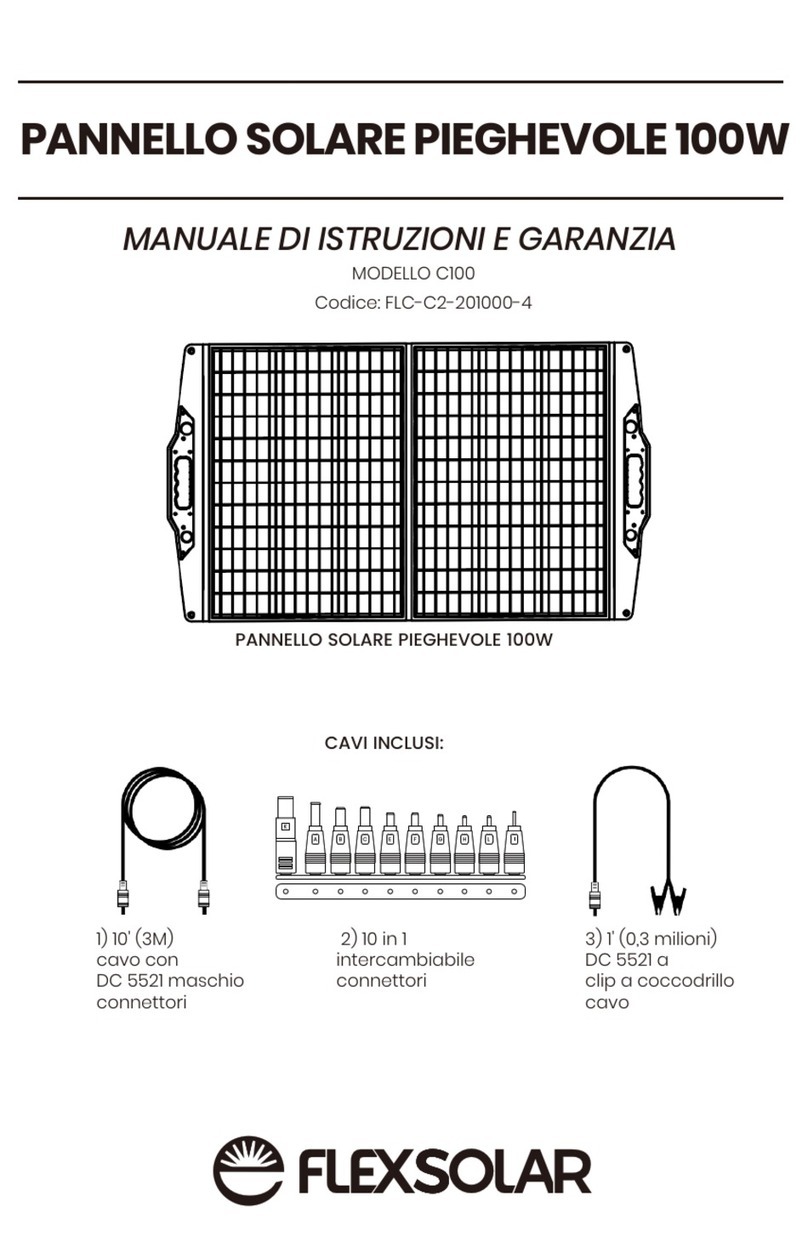
Flexsolar
Flexsolar C100 Instruction manual & warranty
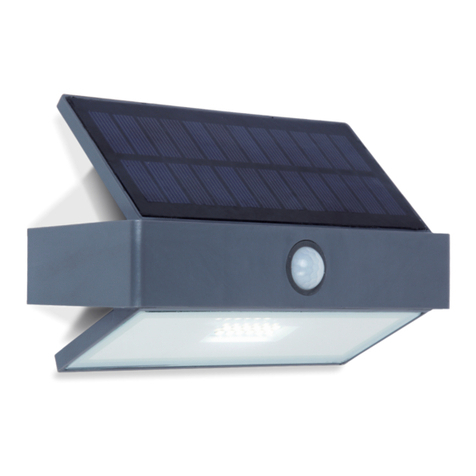
LUTEC
LUTEC ARROW 6910601335 user manual
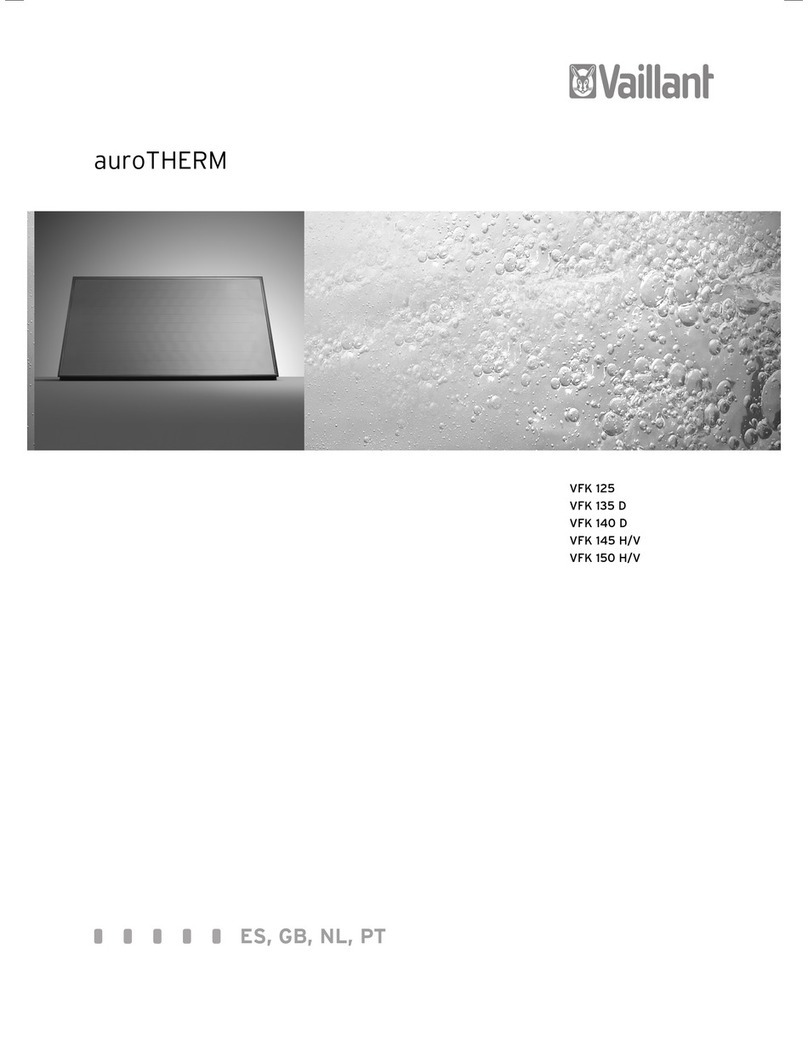
Vaillant
Vaillant auroTHERM VFK 125 installation manual

Philadelphia Solar
Philadelphia Solar PS-M72 Series Installation & operational manual
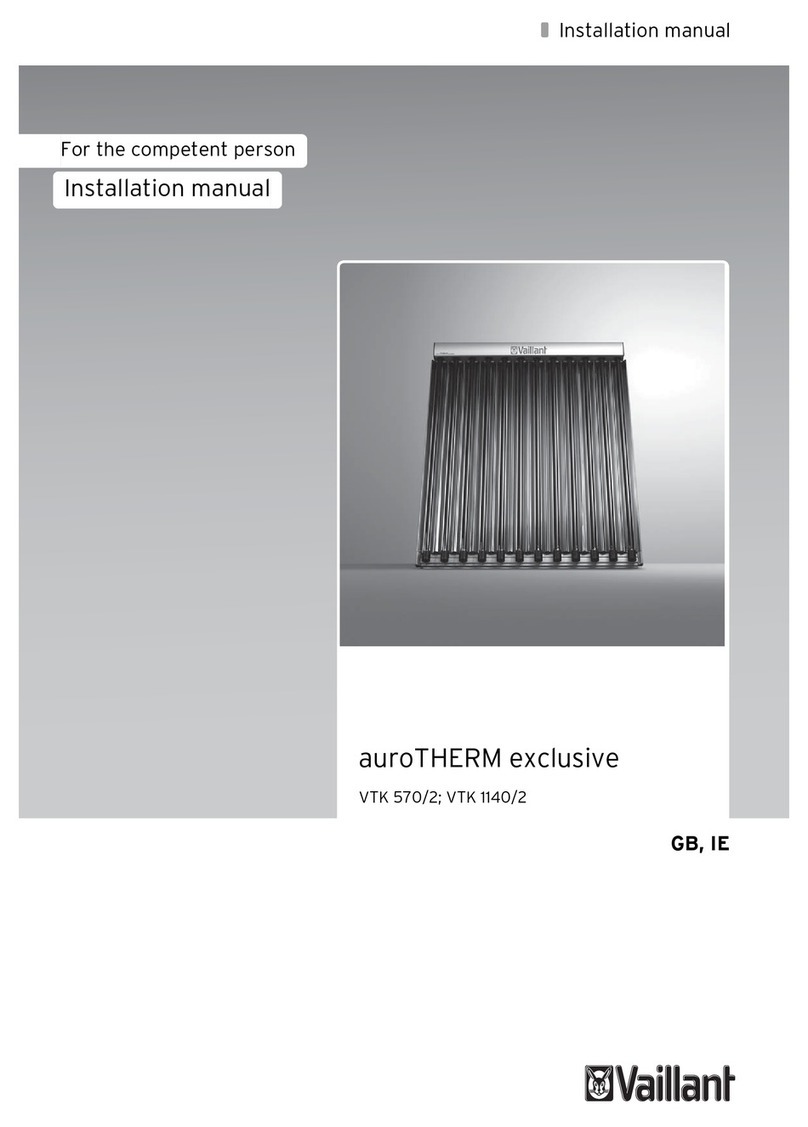
Vaillant
Vaillant auroTHERM exclusive VTK SERIES installation manual
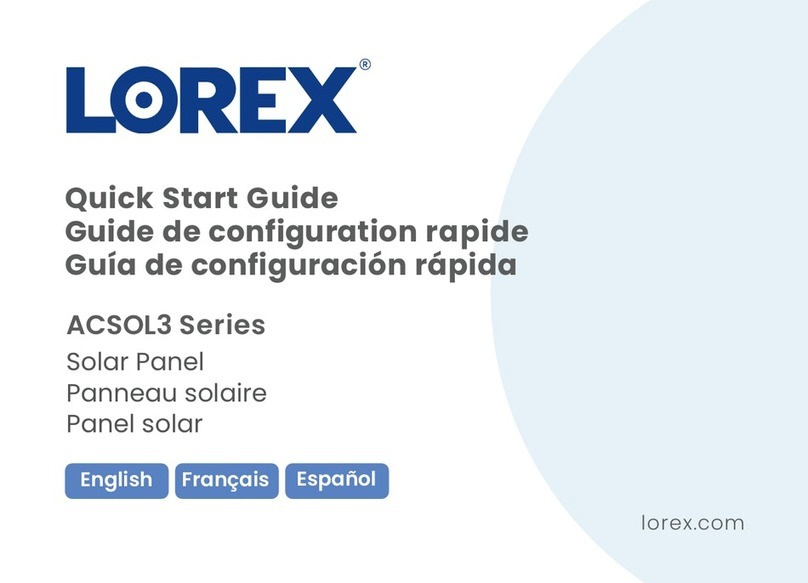
Lorex
Lorex ACSOL3 Series quick start guide

Steinbach
Steinbach speedsolar Series manual

Kyocera
Kyocera OIL AND GAS brochure
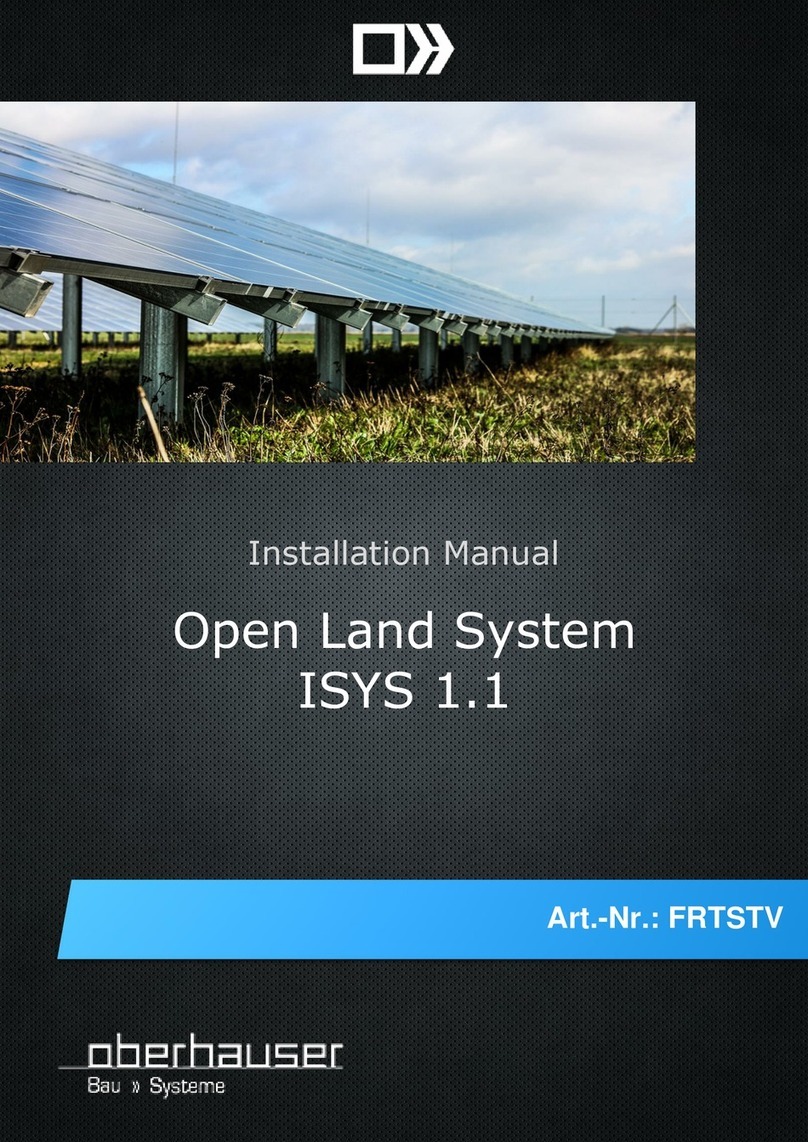
Oberhauser Bau-Systeme
Oberhauser Bau-Systeme ISYS 1.1 installation manual

ACOPOWER
ACOPOWER HY-PLK-100WPX20A manual
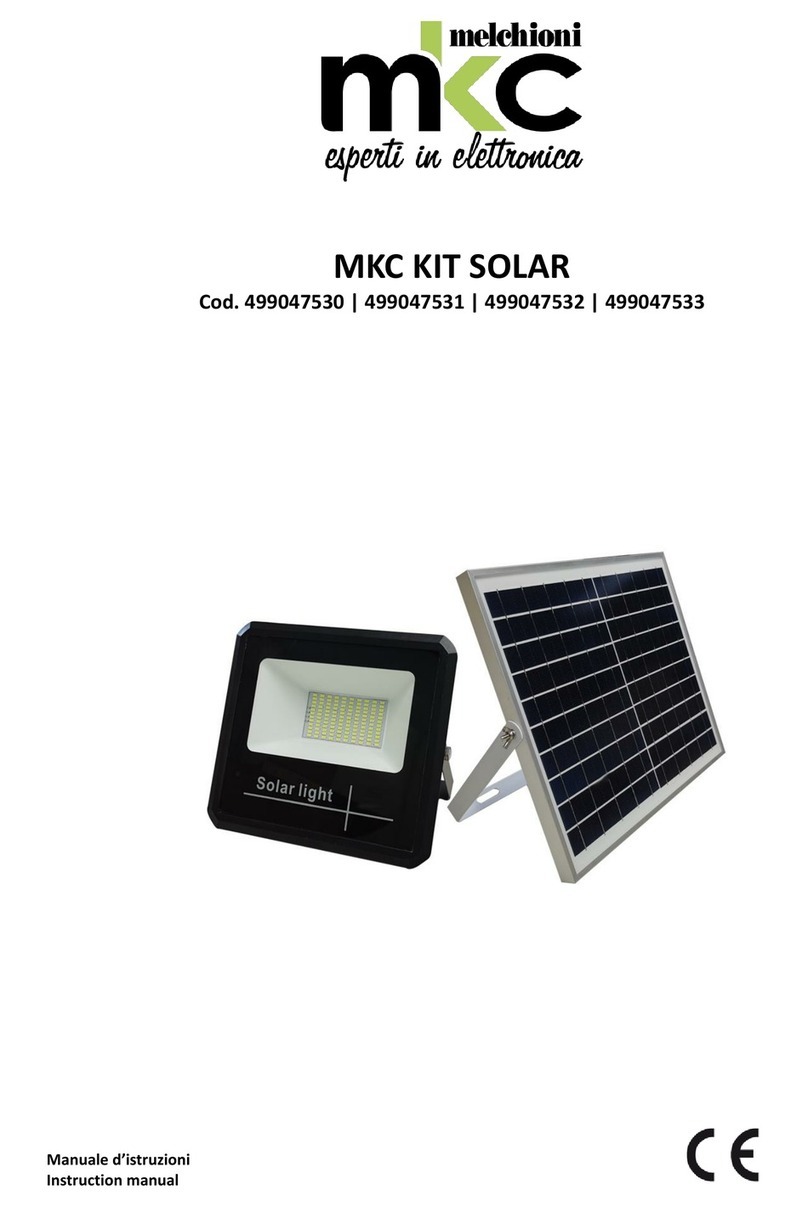
MKC
MKC 499047530 instruction manual

Viessmann
Viessmann VITOSOL 200-F Installation instructions for contractors
